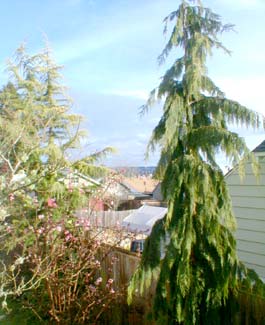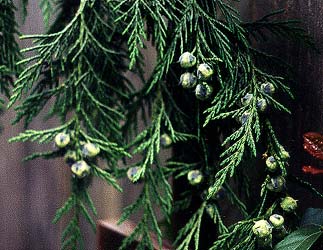 Weeping Alaskan Blue Cedar
Weeping Alaskan Blue Cedar
"The wonder is that we can see these trees and not wonder more."
-Ralph Waldo Emerson
(1803-1882)
(1803-1882)
Here's our young Weeping Alaskan Blue Cedar (Chamaecyparis nootkatensis 'Glauca Pendula'), a native species. This weeping-plumes occur not merely with such cultivars as 'Glauca Pendula.' but also naturally in the wild. This habit is adaptive, so that it can grow in places with heavy snowfall without losing its branches.
When it snows on our garden, most of the trees get their limbs weighted down, but this Alaskan cedar pokes up straight as an arrow with hardly a bit of snow clinging to its slippery needles & limbs. Another variety called 'Green Arrow' holds its limbs even closer to the trunk; but ours does have some outstretching branches near the bottom.
 It's not a True Cedar of course, & some people call it a Nootka Falsecypress, since it's not a cypress either.
It's not a True Cedar of course, & some people call it a Nootka Falsecypress, since it's not a cypress either.We planted the Alaska Weeping Cedar in 2001 when it was probably about twelve feet high. It has put on a good foot to a foot & a half each year. Because of its strongly weeping branches, its width does not outgrow a smallish to medium-sized yard despite its swift attainment of height. The photo above is from February 2005, as viewed from our raised deck.
The second photo (at right) taken in May 2002 is of the blue & green fruit. The half-inch globe-shaped female fruit is dense & hard & doesn't seem to interest the birds or our squirrel visitors. It takes a full year for these cones to turn into round brown cones.
Male fruit (pollen-bearing strobili) are not in evidence in the May photo, but can be quite numerous on the same branches with the see-cones, though comparatively inconspicuous as tiny rust-colored & yellowish bumplets at branch tips. Any given year's female cones are wind-polliniated the previous spring.
This tree was formerly rarely seen in garden landscapes, cultivars of a Japanese species having been more commercially available. But in 1997 the weeping C. nootkatensis received the Cary Award for distinction as a specimen tree & for adding "a note of grandeur" even to the starkest winter-landscape (see the Alaska Cedar Page along the Winter Bark Garden Walk), & has since become better known.
In the garden it rarely exceeds 30 feet in height; if the soil is not acidic or is too dry, it will be smaller still. But adult trees in the wild can be 80 or 100 feet tall, among the most majestic seen on high cliffs along the coast of Alaska, British Columbia & especially Nootka on the coast of Vancouver Island. The largest Nootka Cedar recorded, however, is in the Olympic National Forest, not far from where Granny Artemis & I live. It is 125 feet tall. These are also extremely long-lived trees, three hundred years being common, to over a thousand years.
It prefers high humidity & rich acidic soil, but is hardy under less than ideal conditions so long as it has a lot of sun & moist well-drained earth. Young trees are shade-tolerant especially in the southern part of their range (Oregon) & may prefer some protection from summer heat. In the northern part of their range (Alaska) saplings do not fare well in shade & forests are usually evenly aged, with no young understory specimens. From mid-coast along British Columbia & in Washington they prefer the sun, though a little shade won't harm.
I've planted native wild gingers in the shade & needly loam beneath this tree, as that's the exact environment that little ground cover prefers.